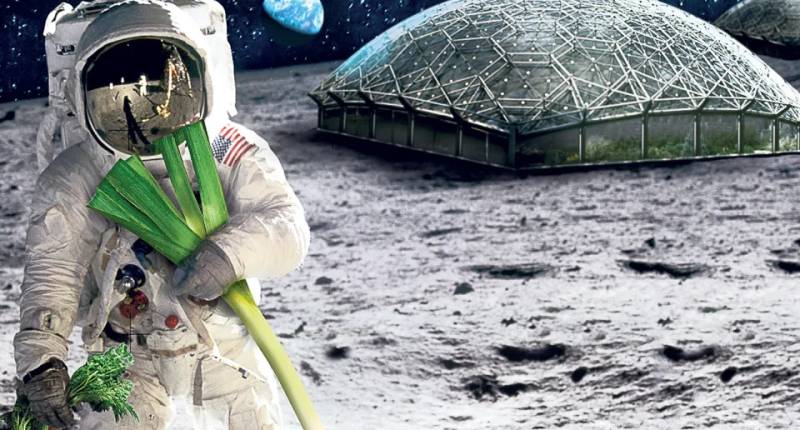HOBBIT-LIKE homes, “Jeep” rovers, robots, and vertical gardens could allow humans to live comfortably on the Moon by 2100, The Sun can reveal.
Countries across the world are battling for claim over the Moon’s south pole – said to be full of “mystery, science, and intrigue”.
While the Moon cannot legally be owned by a nation or organisation, anyone who establishes a base there will have a piece of real estate.
Key players including Nasa, China, Russia, India, and the European Space Agency – which the UK is a part of – have recently ramped up efforts to create a more permanent human presence on the Moon.
The world is witnessing multiple attempts at a “land grab” of the Moon’s south pole as it likely contains ice – an invaluable resource for future exploration.
Martin Barstow, a professor of astrophysics and space science at the University of Leicester, outlined how the area could look in 76 years.
Read more on the moon
Speaking to The Sun, he said ice at the Moon’s poles could be used to produce crucial supplies including oxygen and water.
He said: “If you want to be there more permanently, then you have to create infrastructure that has to be supplied from the Earth. That’s expensive.
“So you need to also work out how much of it you can manufacture on the Moon.
“I think what you’ll find is there is a lot of activity going on near the poles where there are likely to be sources of ice from which you can manufacture oxygen, and also from which you can extract water.”
Most read in Science
The critical supplies could, by the end of the century, be used to sustain up to 100 people on the Moon, Prof Barstow said.
Some people will be there for research purposes, while others will be there for commercial reasons.
There also could be some “very rich” tourists.
Prof Barstow estimated that going to the Moon could cost tens of millions of pounds – the cost of going into low Earth orbit.
As there is no atmosphere on the Moon, whoever wants to live there in 2100 will have to live in some kind of sealed environment.
Inspiration could be taken from the International Space Station – the largest space station ever built – that is currently in low Earth orbit.
Living quarters on the space station look like a collection of tubes joined together with modules that can be added to over time.
Any future lunar bases will likely have to be buried in the ground as a means of protecting humans from radiation, which is a greater threat on the Moon than it is on the space station.
Prof Barstow explained: “Low Earth orbit is relatively safe environment from a radiation point of view.
“Once you get outside that zone, and certainly out as far as where the Moon is, you have to protect humans from radiation.
“That will involve probably piling up a lot of material from the lunar surface on top of whatever it is you build. So a bit more like a Hobbit hole, if you remember Lord of the Rings.”
Plans are already underway to develop a rail network for operation on the Moon that will be able to transport both humans and supplies.
I would foresee that a kind of human-robot hybrid way of working on the Moon is what is likely to develop
Prof Martin Barstow
People will also likely be using lunar rover vehicles that resemble a Jeep to get around, Prof Barstow said – but will have to drive slower and with more care than they do on Earth.
The Moon’s surface is famously rugged and covered in craters.
Human residents of the Moon will need to be supported by robots that are autonomous but can also be controlled, at least to some extent, by humans.
They will not resemble humans too closely but will have arms to grab and move things around, as well as cameras, instruments to make measurements, and other helpful features.
Prof Barstow said: “I would foresee that a kind of human-robot hybrid way of working on the Moon is what is likely to develop.
“The robots can go into the more dangerous places.
“They can exist on the surface without life support for long periods of time and I think that relationship is going to be absolutely critical for how things develop on the Moon in the future.”
People going to the Moon for no other reason but for a holiday, or for commercial reasons, could get there in vehicles like the Falcon 9, designed by SpaceX to carry cargo and crew into Earth orbit.
Elon Musk‘s SpaceX has successfully landed Falcon 9 boosters 273 times, as of Monday, March 25.
The Moon – our closest neighbour explained
Here’s what you need to know…
- The Moon is a natural satellite – a space-faring body that orbits a planet
- It’s Earth’s only natural satellite, and is the fifth biggest in the Solar System
- The Moon measures 2,158 miles across, roughly 0.27 times the diameter of Earth
- Temperatures on the Moon range from minus 173 degrees Celcius to 260 degrees Celcius
- Experts assumed the Moon was another planet, until Nicolaus Copernicus outlined his theory about our Solar System in 1543
- It was eventually assigned to a “class” after Galileo discovered four moons orbiting Jupiter in 1610
- The Moon is believed to have formed around 4.51billion years ago
- The strength of its gravitational field is about a sixth of Earth’s gravity
- Earth and the Moon have “synchronous rotation”, which means we always see the same side of the Moon – hence the phrase “dark side of the Moon”
- The Moon’s surface is actually dark, but appears bright in the sky due to its reflective ground
- During a solar eclipse, the Moon covers the Sun almost completely. Both objects appear a similar size in the sky because the Sun is both 400 times larger and farther
- The first spacecraft to reach the Moon was in 1959, as part of the Soviet Union’s Lunar program
- The first manned orbital mission was Nasa’s Apollo 8 in 1968
- And the first manned lunar landing was in 1969, as part of the Apollo 11 mission
Moon tourism in 2100 may only be for the uber wealthy, but it is unlikely travellers will be eating like kings or queens.
Freeze-dried and pre-packaged meals and drinks will probably still make up the majority of a person’s diet, but Prof Barstow predicts growing “practical volumes” of produce may be made possible over a period of a decade or two.
Last year, scientists were able to grow thale cress – a small flowering plant of the same family as cauliflower and broccoli – in 12 Moon soil samples from the Apollo 11, 12, and 17 lunar landings.
Vegetables and fruits could be grown vertically on the Moon in the future, as gardens would be more compact, using artificial light.
Because of the way the Moon’s rotation is locked with its orbit around Earth, a month on the Moon is comprised of two weeks of sunlight followed by two weeks of total darkness.
Future travellers might therefore need to think carefully about their travel dates, if they want some sunshine.
Prof Barstow said: “One of the real challenges of working on the Moon is power.
“You think it’s easy to get solar panels solar panels up there, and yes, they work really nicely, but they only work for two weeks.
“So solar panels are not really very helpful for the two weeks when you don’t have any sunshine.”
There will likely be a “whole lot” of small modular nuclear power plants on the Moon needed to support humanity in 2100, he added.
Nations race to the Moon’s south pole
The lunar south pole has been a site of interest to space-faring nations including India, Russia, China and the US.
Last year, India made history by becoming the first country to land near the southern site.
Days earlier, Russia also made an attempt at a south pole touchdown, which ended in a crash landing.
READ MORE SUN STORIES
Nasa’s Artemis III mission is to explore a region near the lunar south pole.
The mission is an important part of a years-long plan to construct a permanent lunar base by the end of the decade.
Nasa’s Artemis lunar mission – key facts
Nasa’s Artemis lunar mission – key facts
- Nasa has pledged to land man on the Moon in 2024
- The mission, dubbed Artemis, will mark the first time astronauts have set foot on the lunar surface since 1972
- A giant Nasa rocket dubbed the Space Launch System will carry astronauts beyond Earth’s atmosphere
- Once at the Moon, two astronauts will descend to the surface from an orbiting craft called the Lunar Gateway
- Nasa has pledged that one of the landing crewa will be female, marking the first time a woman has set foot on the Moon
- The pair would land on the lunar south pole, where vast reserves of frozen water could be tapped for future explorers
- The landing system that brought the astronauts to the surface will then blast back to the orbiting Gateway satellite
- They will board an Orion capsule for the 250,000-mile trip back to Earth
- Nasa has a mountain of technical challenges to overcome before Artemis gets the green light
- It’s still not clear if everything will be ready in time for the ambitious 2024 launch date
- Nasa boss Jim Bridenstine has said the Moon will serve as a critical training ground for Mars expeditions, perhaps in the 2030s
This post first appeared on Thesun.co.uk















